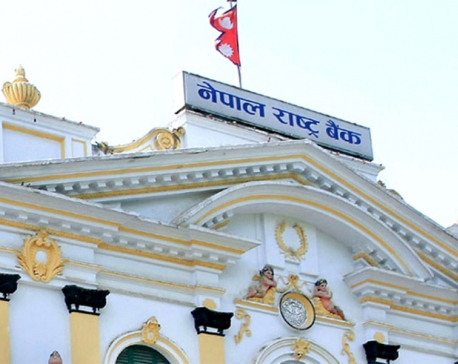
OR
BFIs, NRB blame each other for credit crunch problem
Published On: February 2, 2017 03:44 AM NPT By: Republica | @RepublicaNepal
Private sector says it was paying the price
KATHMANDU, Feb 11: Bankers have lamented the inaction of Nepal Rastra Bank (NRB) toward addressing the existing problem of credit crunch.
However, the central bank says that there is nothing that it can do for now to resolve the problem created by the bank and financial institutions (BFIs) themselves. Senior NRB officials have accused aggressive lending by BFIs for the current mismatch in their assets and liabilities which has resulted into shortage of loan-able fund.
“Banks aggressively extended credit on less productive sectors as well as on share market, auto and real estate, among others. However, their deposits did not rise in the same ratio due to slowdown in remittance growth and huge treasury surplus,” Chintamani Shiwakoti, a deputy governor of the NRB, said, speaking at an interaction on 'Banking Industry's Current Situation and Way Forward' organized by the Nepal Bankers' Association (NBA) in Kathmandu on Wednesday.
He also urged the BFIs to raise interest rates on saving deposits to attract more fund to overcome the current credit to core-capital-cum-deposit (CCD) ratio problem. As stocks of deposit is depleting, many commercial banks are now seeing their CCD ratio rise above 80 percent -- the upper limit set by the NRB.
The CCD requirement that the central bank enforces to maintain adequate liquidity in the system allows a bank to lend only up to 80 percent of its total deposits and core capital. It says that 20 percent should be held as cash reserves and government securities investment, among other liquid assets. For example, if a bank's total deposits and core capital amounts to Rs 100, it can only lend up to Rs 80 and maintain Rs 6 as cash reserves and Rs 8 in government securities investment, among others.
According to Shiwakoti, CCD ratio of as many as 21 commercial banks has crossed the 80 percent ceiling, implying that they cannot lend without adding fresh deposits. He also warned that the central bank would take action against those banks by the quarter-end if they do not maintain their CCD ratio within the regulatory requirement.
However, bankers have a different story to share. They say that the current crisis is the result of structural problem of the economy. “As the paid-up capital has been raised by 300 percent in two years, it is natural for banks to increase their portfolio and credit expansion to give justifiable return on equity for our shareholders,” Kishore Maharjan, a vice president of NBA, said. “The central bank should also have made forecast of the problem in mid-July. It should have told us what would be the effect if development budget is not spent. NRB should have cautioned us before the CCD ratio burst,” he added.
Narayan Prasad Paudel, an executive director at the NRB, was blunt in blaming the BFIs for the current mess. “Deposit has not grown in the BFIs compared to the rise in lending. There has not been proper assessment by the BFIs about their capacity. They could not make calculation on how much they can mobilize deposit and how much they can lend. This is where they failed and the CCD ratio reached to a saturation level,” he added.
As the problem worsens with central bank and BFIs blaming each other, private sector leaders say that they are paying the price for the problem. “The economy is showing a good sign as the country is on the growth track. We are seeing growth in sales. But, there is no fund in the banking system for lending, while interest rates are alarmingly high on available loans,” Pashupati Murarka, president of Federation of Nepalese Chambers of Commerce and Industry (FNCCI), said.
You May Like This

NRB tells BFIs to stop interest rate distortion, other anomalies
KATHMANDU, Feb 9: Concluding that the banks and financial institutions (BFIs) are perpetuating anomalies in the financial sector, Nepal Rastra Bank... Read More...

NRB shrugs off liquidity crunch in face of 'aggressive lending' by BFIs
KATHMANDU, Jan 10: As banks and financial institutions (BFIs) up their 'aggressive' lending, Nepal Rastra Bank (NRB) has taken a cautious... Read More...

NRB to act strict against BFIs leaving merger midway
KATHMANDU, Sept 9: Alarmed by the rising cases of merger and acquisition (M&A) process of bank and financial institutions (BFIs) collapsing... Read More...







Just In
- NRB to provide collateral-free loans to foreign employment seekers
- NEB to publish Grade 12 results next week
- Body handover begins; Relatives remain dissatisfied with insurance, compensation amount
- NC defers its plan to join Koshi govt
- NRB to review microfinance loan interest rate
- 134 dead in floods and landslides since onset of monsoon this year
- Mahakali Irrigation Project sees only 22 percent physical progress in 18 years
- Singapore now holds world's most powerful passport; Nepal stays at 98th











Leave A Comment